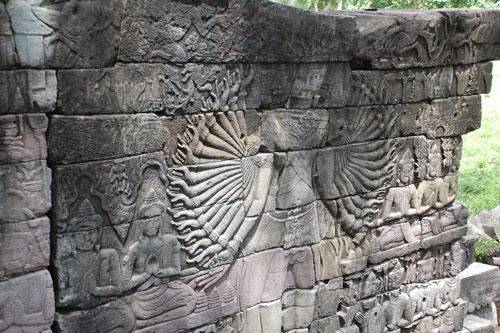| Videos | • Latest |
|
• Feature | • Sports | • Your Videos |
2nd Angkor Wat to wake

 0 Comment(s)
0 Comment(s) Print
Print E-mail CNTV, April 13, 2012
E-mail CNTV, April 13, 2012
The temples at Banteay Chhmar, dubbed as Cambodia's "Second Angkor Wat" are slowly returning to life after eight centuries of isolated slumber.
 |
|
Temples at Banteay Chhmar. |
Archaeologists have been invited to rebuild the ancient temples stone by stone. With landmines cleared and roads being paved, the temples will soon be on the tourist trail.
The famous temples at Angkor Wat are Cambodia's biggest tourist attraction, drawing around 7-thousand tourists a day from around the world.
Yet 160 kilometers to the west, in Banteay Chhmar, the scene couldn't be more different.
Known as Cambodia's "Second Angkor Wat", the 12 square kilometer complex of ancient Angkorian temples attracts just one or two visitors a day. The temple was built by King Jayavarman VII in the 12th Century - shortly after he constructed Angkor Wat - to commemorate his son, who was killed in battle.
After centuries of neglect, many of the temples have collapsed while others have been swallowed up by dense undergrowth. But there's more that keeps it from being a mass tourist attraction.
Yim Sothin, Director of Dept. of Safeguarding Banteay Chhmar, said, "There were many landmines in Banteay Chhmar. There are still a lot of unexploded landmines around here. Also, the road up here is very bad so it was hard for tourists to get to the temples at Banteay Chhmar."
|
|
|
Banteay Chhmar temple |
In 2008, after almost a decade of work in the area, the Cambodian Mine Action Center declared the site of the temples free from landmines, allowing restoration work to begin.
A new road connecting Banteay Chhmar with the provincial capital Sisophon is almost complete. It will cut the journey time from eight hours to less than three.
To rebuild the temples, the government sought outside expertise - teaming up in 2008 with veteran British archaeologist John Sanday from the California-based Global Heritage Fund, who has spent twelve years restoring temples at Angkor Wat.
Rebuilding the temples at Banteay Chhmar is likely to take decades to complete. But Sanday's strategy is to train his team to a professional standard so that they can carry on the work after he's gone.
John Sanday, Director of Banteay Chhmar Temples Restoration, said, "The whole process is one of imparting knowledge and experience to these people on site and the ambition, really, is that we would eventually hand over a complete conservation unit of professionals - architects, archaeologists."
Only the most intrepid traveller makes it out to Banteay Chhmar at the moment, but Sanday knows that mass tourism - like at Angkor Wat - could one day become a reality.







Go to Forum >>0 Comment(s)